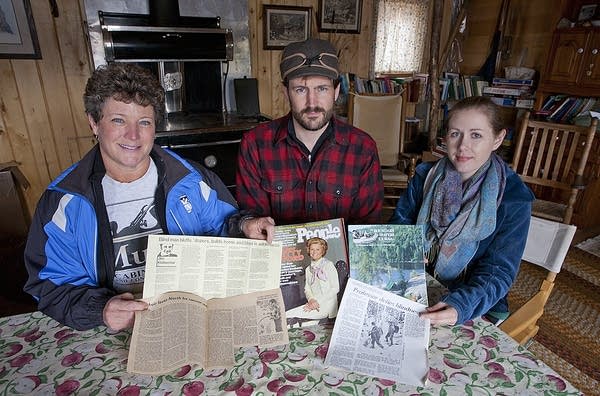It's cabin-opening season for some Minnesotans
Go Deeper.
Create an account or log in to save stories.
Like this?
Thanks for liking this story! We have added it to a list of your favorite stories.

Inside a simple, brown cabin that overlooks a narrow bay of an isolated lake, Peggy Marshall pulls open the door of a cast-iron wood stove to start an annual rite.
"We'll build a little fire in here, and take the chill off," said Marshall, who has come to the cabin every summer for more than 40 years.
Outside, a giant old-growth red pine towers overhead and a loon pops to the lake's tranquil surface.
Every Memorial Day weekend, the postcard-like scene and the memories it evokes draws families like Marshall's to clogged highways, as they head for summer cabins.
Turn Up Your Support
MPR News helps you turn down the noise and build shared understanding. Turn up your support for this public resource and keep trusted journalism accessible to all.
With the long winter and late ice-out on many lakes, for some this could be their first visit since last fall.
MORE COVERAGE
• Story: Family fought to keep rustic wilderness
• Photos: Family cabin getaway for four generations
• Tell us: Is owning a cabin part of your Minnesota dream?
• MN Today: Send us your cabin photos
The two-room cabin has a small screen porch, but still has no running water. Electricity arrived only a year ago, thanks to a small solar panel. But there's only one outlet and just three lights.
Marshall and her 29-year-old son, Bill, live about an hour south in Grand Rapids. After driving up earlier this month, they went to work, lighting the fire and hauling water. Then they carried an aluminum dock frame to the water, even though it was sleeting outside.
For Peggy Marshall, 54, the cabin's routines date back to 1968, when her parents bought the place.

"I was ten years old, and we were really excited about buying it," she said. "Us kids wanted that cabin really badly, because it was like a playhouse."
Back then, it was a real trek to the playhouse. Her father, Bill Muir, was a botany professor at Carleton College in Northfield, Minn., 260 miles to the south. Shortly after they bought the cabin he lost his eyesight to diabetes.
But although he only saw the place a couple times, that didn't dampen his enthusiasm for wilderness. He eventually paddled more than 2,000 miles in the Boundary Waters Canoe Area, and testified at Congressional hearings held on whether the area should be motor free, as it remains today. The family headed north nearly every weekend in the summer and also visited during other seasons.
"He always worked until way late on a Friday, and my mom would work with him, because she was his eyes after he went blind," Marshall said. "Then we'd drive up here in the middle of the night, get here at like two in the morning."
The journey was even longer in the winter.

"We had to walk the last mile. They didn't plow this road, so we had snowshoes and we'd pull little plastic toboggans behind us," Marshall recalled. "It was a mile in, on snowshoes with four kids and a blind man and my mom!"
When Marshall was in the 8th grade, her father took a sabbatical to write a book.
" 'White Cane in the Wilderness' was going to be the title, because he was a big wilderness guy and he was blind," she said, adding that her father never wrote it. "Instead we worked on the place pretty much the whole time."
The family spent a sabbatical year together in the original structure which had only one room. Six people. One room. No electricity. No running water.
"We all lived up here, through the whole winter, and it was not really well insulated, we had Styrofoam boxes glued to the ceiling. We had mice. We'd wash our hair at night and then go to bed, wake up in the morning with our hair frozen to the wall a few times."
Her younger brother, only 12 at the time, led construction on a new cabin. Her father inspected the work with his hands, to ensure it met his specifications, even though he had never built anything before either. But they finished it -- four kids and a blind man -- and it's still standing solidly. They didn't add plumbing and electricity when they had the chance. The family even fought to keep power out of the area to ensure it wouldn't be developed.
Bill Muir took his last trip to the cabin in 1985. He died in his beloved wilderness getaway that summer.
His family has returned every year, to toil and remember.
For Patty Marshall and son, the work, the weather and the tough times, were all worth it.
"It's very special. It's definitely a significant part of my life," Bill Marshall said. "It's hard to imagine what my childhood would have been like without having the cabin."
His mother often wonders why she doesn't come to the cabin more often.
"When you get here it's just so wonderful," she said. "It's such a getaway, everything you have to do at home is left behind. It's just letting go of responsibility."
That's a feeling four generations of Muirs have shared.
"It's a very huge piece of our family, both my family growing up, and my children," Marshalls said. "And now the grandkids, they're coming too, carrying on that tradition of going to the cabin."
Dear reader,
Political debates with family or friends can get heated. But what if there was a way to handle them better?
You can learn how to have civil political conversations with our new e-book!
Download our free e-book, Talking Sense: Have Hard Political Conversations, Better, and learn how to talk without the tension.






